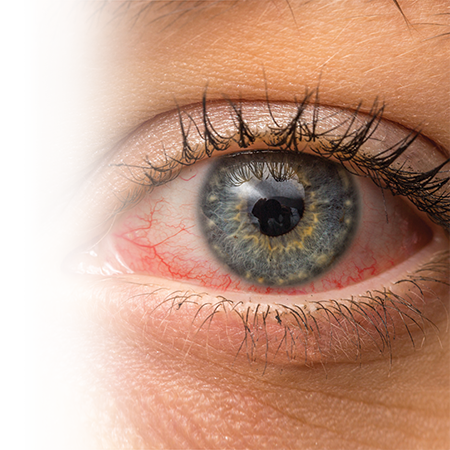Conjunctivitis is a common, usually harmless, eye condition. It can be prevented and treated, but it must first be recognized.
What is conjunctivitis?
Conjunctivitis is the inflammation of the conjunctiva, the thin, transparent layer that covers the inner eyelid and whose primary function is to produce a lubricating substance that prevents the eye from drying out.
There are various types of conjunctivitis, including:
- Viral conjunctivitis, caused by a highly contagious virus, often occurring during or after a cold.
- Bacterial conjunctivitis, caused by bacteria.
- Irritative conjunctivitis, caused by irritating agents (smoke, dust, cold, wind, chemicals, foreign objects, etc.).
Allergic conjunctivitis, caused by an allergen (pollen, animal hairs, dust, dust mites, mould, etc.).
How to recognize conjunctivitis
The signs and symptoms of conjunctivitis are mainly as follows:
- redness of the eye
- burning or foreign body sensation
- lacrimation or purulent discharge
- pain
- itching
- crusting of eyelashes (especially upon awakening in the morning)
It may be difficult to distinguish between the various types of conjunctivitis on the basis of signs and symptoms. However, some observations are more telling than others.
For instance, viral or allergic conjunctivitis often affects both eyes. Moreover, significant itching and lacrimation occur in cases of allergic conjunctivitis. On the other hand, bacterial conjunctivitis generally affects only one eye and is often combined with purulent yellowish or greenish secretions that stick eyelids together (especially upon awakening in the morning).
A doctor or optometrist can make a diagnosis and determine the causes of conjunctivitis.
How can conjunctivitis be prevented?
Here are a few tips on how to prevent conjunctivitis.
- Wash your hands frequently. Viral or bacterial conjunctivitis generally spreads through hand-to-eye contact.
- Don’t touch objects that have been manipulated by an infected person, and avoid close contact with him/her.
- Don’t share make-up, towels or washcloths.
- If you wear contact lenses, take good care of them and follow the instructions for use.
- Avoid all exposure to the allergens at the root of your allergies, if applicable.
- Wear protective glasses if you manipulate products or objects that could cause eye damage.
How can conjunctivitis be treated?
Most cases of conjunctivitis get resolved on their own. This can take several days.
Antibiotic drops and ointments can be effective against bacterial conjunctivitis, but are of no use in the case of viral conjunctivitis. Some of these products must be prescribed by a doctor or optometrist; others are available over the counter, but a consultation with the pharmacist is required to obtain them.
To treat allergic conjunctivitis, prescription or over-the-counter ophthalmic antihistamine drops can be used. These products relieve eye allergy symptoms, particularly itching and lacrimation. Oral antihistamines provided over the counter can also help to ease symptoms.
In the case of irritative conjunctivitis, the use of lubricating eye drops can help to alleviate symptoms and to promote comfort and healing.
Be sure to wash your hands properly before and after administering an ophthalmic product (drops, ointment, collyrium, etc.). Once the product has been opened, it must be thrown out after a month (to limit the risks of microbial contamination). Never use a product that is outdated or for which the appearance, odour or consistency is unusual. Closely follow the pharmacist’s instructions regarding the treatment.
What if I wear contact lenses?
If you have conjunctivitis and you wear contact lenses, it is best to consult an optometrist or a doctor. You will probably have to stop wearing them temporarily. If they are disposable lenses, throw them away and wait until the infection has healed before wearing new ones. If they are not disposable lenses, they must be disinfected before wearing them again once the infection has healed. Ask your optometrist for advice.
Don’t hesitate to speak to your pharmacist for additional information about conjunctivitis and its treatment.

